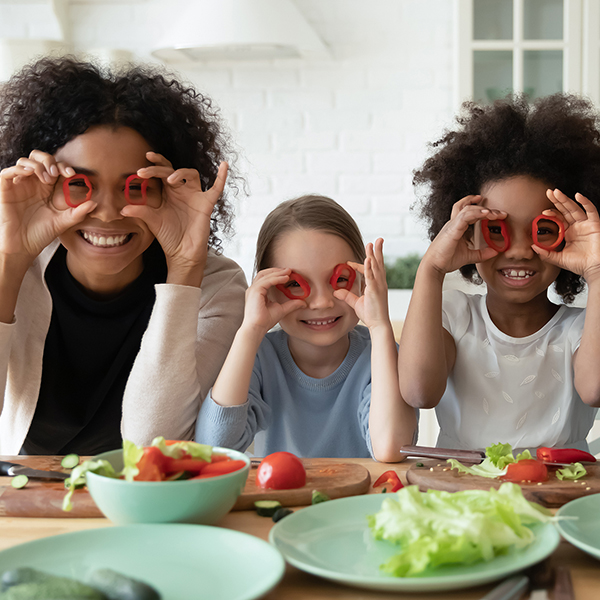
Picky Preschool Eating
There’s a reassuring element in knowing that you’re not alone in dealing with a parenting challenge. For example, having a child who’s a picky eater. According to nutritionists, parents and MyPlate.gov, this is a very common occurrence, especially among the preschool age groups.
“Picky eating is typical for many preschoolers as they grow up and become more independent,” confirms MyPlate.gov. Some strategies for getting your preschooler to eat healthy foods that the institution suggests, is to try and balance the amounts and types of foods eaten over one week; offer a variety of different foods; maintain small portions at meal and snack times; introduce new foods alongside familiar foods; and let the child help in meal preparations.
This advice is on par with what a handful of local moms do here in Santa Cruz to combat picky eating.
Moms Share Their Tips & Tricks
“I involve them in shopping, choosing the menu for the night, and food preparation as much as possible,” said mother of two, Amelia Schmale. “When I make [my son’s] plate, I give him just a little bit of each thing so as not to overwhelm and allow him to choose. For example, I would give him one or two slices of carrots, bell pepper, snap peas, and celery. He might eat some, he might eat one, he might eat all. He also likes dip! My son likes blue cheese dressing. We like the Toby’s brand. It has less fake stuff in it. He will eat lots of veggies dipped in this.”
Another Santa Cruz mom introduced fruits and veggies to her son early on. “My youngest son, who is now three, usually only wants fruits and veggies,” said Alisha Marie. “I think introducing veggies at a very young age and to continue feeding them those with every meal was important.”
Santa Cruz mom, Sarah Cipollina, says that she makes sure that proteins and veggies are eaten before snacks and treats. “We made it a common practice to eat protein and a veggie before having any snacks or treats, not as a punishment/reward system. More of a matter-of-fact way of explaining the order foods should be eaten,” she said. “Also, really getting to know their favorite veggies of the moment and having them on hand helps.”
“We would cut up small pieces and place them into ice cube trays; a variety of fruit, veggies and crackers,” said a Watsonville mom, Jennifer K. “Some would be new, some would be favorites and some would be a food previously rejected. I would set a tray out. They would graze usually favorites first but when those were gone the others started disappearing.”
One Soquel mom, Amber Watkins, added that local Montessori schools are a big help with preschool nutrition. “Send them to Montessori schools. They do an amazing job at getting kids to eat fresh fruit and vegetables,” she said.
“For red pasta sauce, I grate onions, celery, carrots, zucchini and pepper, and then cook until they’re soft and not noticed by the kids anymore,” said Ben Lomond mom, Marieke Reijn-Koehorst, who also specifies that there is a good recipe found online from Jamie Oliver.
“You can also blend in butternut squash or cauliflower with cheese sauce pasta.”
Another Santa Cruz mom, Jen Slaughter Michelsen, shares a couple of her tricks: “I’ve always asked that my kiddo first try three bites of any new food before I accept her inevitable rejection,” she said. “Then, I would offer her preferred healthy option. I offer sliced veggies as a before-dinner snack to satisfy those hunger pains, and it helps get vegetables in before dinner is served.”
“I would make pancake batter in the blender and toss in a handful of spinach, peas or whatever I had in the refrigerator,” said Kim Furnish, a mom living in Bonny Doon. “When you cook the pancakes and put a bit of low sugar jam or syrup on top, the littles couldn’t tell! I did the same thing with pasta sauce. Put the sauce in the blender with kale or spinach and then get fun shaped pasta. They loved it and had no clue it had veggies in it!”
Meghan Oona Clifford, of Aptos, shares her unique perspective on raising a vegan family. “We’re a vegan family and our kids love all the food! They eat every single veggie and fruit they can, plus all the foods I shunned as a kid – mushrooms, olives, sauerkraut, etc.,” she said. “Our problem is that we have to bring in our own food to the daycare. I’m surprised they don’t automatically offer a vegan option. I’ve heard that in the UK it’s a protected belief system and all institutions have to offer it, and that makes sense to me.”
Santa Cruz mom Jamie Lafollette, shared something she heard from a doctor: “A doctor once told me that toddlers need to see a food ten times before trying it sometimes,” she said. “It’s evolution from watching what things our parents foraged that were safe to eat. Her advice was just keep putting small amounts on the plate… Even if they don’t like them.”
Rhiannon Crain, of Watsonville, dishes on some of her favorite eating techniques. “My mom taught me to grate onions into dishes like guacamole where chunks of onion might otherwise turn off a sensitive eater. [and to] roast all the vegetables! Make sure and use salt,” she said. “My kids brought home the ‘No Thank You Bite’ from their lovely day care in Corralitos [and] were allowed to say no thank you after trying at least one real bite. There was a period of like five years where I didn’t eat the tip of a single asparagus because that is the bite my younger child would eat, so I ate the rest. Parenting is fun!”
Finally, another resource from a Capitola mom, Diana Coatney, comes from a recipe book that Coatney and ten other moms got together to write and publish. The 2013 book is called The Stuff Our Kids Will Eat. “It has some great recipes in it (and adorable kiddos),” said Coatney.
The Professionals Weigh-in
San Jose Nutrition Therapist and Consultant, Sara Leung, shares her professional advice on children’s eating habits. “Separate conversations around what to eat and a child’s health,” she advises. “Health is such an abstract concept, especially for a preschooler. They know they need to eat food and they really want to eat food that’s good for them. Try to find foods they like to eat, enjoy, and when introducing foods, try to make it come from a fun perspective. Getting kids involved in the cooking process is a great integration, too.
“Let your kids play with their food,” Leung continued. “This can get messy, but when kids play, they’re learning, and that’s true for food as much as for anything else. Many kids are fearful of what they don’t know, so let your kids pick up, squish, roll their food, especially new foods you hope they will try.”
Another good resource for families seeking more information, good tips and guidance for their little ones, can be found by visiting their local Women, Infants and Children (WIC) office. “There are great resources out there for parents struggling with picky eaters. WIC, for example, has a pamphlet specifically for picky eaters,” added nutritionist, Jane Gangitano, M.S., CNS. “There are some great resources for families, locally, put out by the state.”
“Overall, don’t worry about it,” says Gangitano. “Have healthy snacks reachable for kids, like at the bottom of the refrigerator or cupboards. Presentation and leaving these healthier options will help to satisfy hunger. Just make it easy for them to access, don’t force and trust they’ll eat what they need.”






